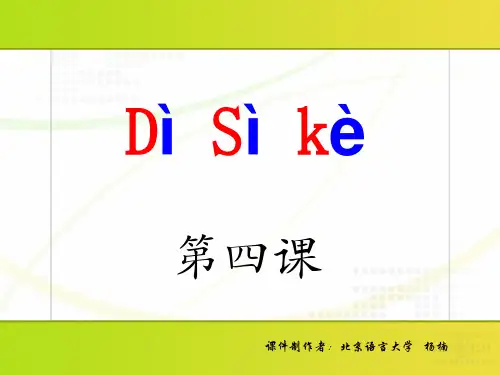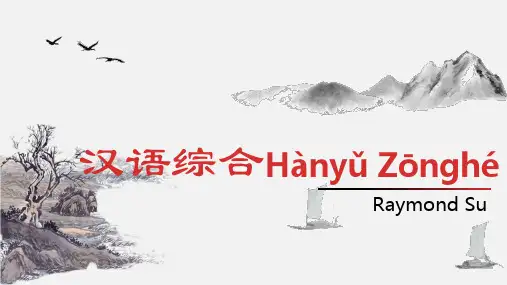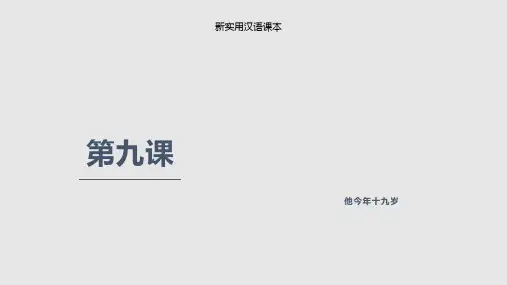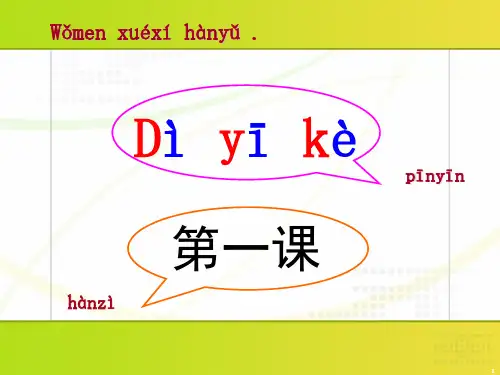- 1、下载文档前请自行甄别文档内容的完整性,平台不提供额外的编辑、内容补充、找答案等附加服务。
- 2、"仅部分预览"的文档,不可在线预览部分如存在完整性等问题,可反馈申请退款(可完整预览的文档不适用该条件!)。
- 3、如文档侵犯您的权益,请联系客服反馈,我们会尽快为您处理(人工客服工作时间:9:00-18:30)。
一 Lesson One
Grammar:
2. The sentences are in an order of subject+predicate e.g. Nǐ hǎo.
Nǐ zǎo. (Good morning) Wǒ hěn hǎo. Lìbō yě hěn hǎo.
一 Lesson One
一 Lesson One
10 basic characters 也(yě):also, too (héngzhégōu+shù+shùwāngōu) shùwāngōu: wān(a curve turning, different from zhé)
一 Lesson One
10 basic characters
一 Lesson One
The PRC(People’s Republic of China) government simplified official characters in 1960s for easier reading and writing. e.g. 馬-马 ,張-张 ,劉-刘,國-国
一 Lesson One
words:
as object: Wǒ xǐhuān(like) nǐ. Ni xǐhuān(like) wǒ ma?
Wǒ zuótiān(yesterday) kànjiàn(saw) tā le.
一 Lesson One
words:
Adverbs: hěn(quite): used with adjectives. yě(also): used with verbs and adjectives. e.g. Wǒ hěn hǎo. Tā yě hěn hǎo. Wǒ zǒu(leave) le. Tā yě zǒu le.
Initials
Wǒmen xuéxí 声母 shēngmǔ .
b(o) p(o) m(o) n(e) l(e) h(e)
Initials
Wǒmen xuéxí 声母 shēngmǔ .
b(o) p(o) m(o) n(e) l(e) h(e)
Finals
Wǒmen xuéxí 韵母 yùnmǔ .
Chinese characters: originated from pictures
一 Lesson One
characters in ancient times
一 Lesson One
official characters(used in Hong Kong, Taiwan, overseas Chinese communities, Japan, Korea)
e.g. bā, pó, lè, nǐ, mǔ, nǚ
When marking on i, remove the dot
e.g. nǐ, lǐ
一 Lesson One
How to mark tones on pinyin:
2. For compound yùnmǔ with n, g: mark on a o e i u ü, not on n g
e.g. hān, lèn, nín, lùn, láng
一 Lesson One
How to mark tones on pinyin:
3. For compound yùnmǔ with more than one of “a o e i u ü”, mark only one of them; choose following an order of
e.g. Dīng Lìbō, Mǎ Dàwéi
一 Lesson One
words:
Pronouns: no difference for subject or object nǐ-you; wǒ-I, me; tā-he, him
as subject: Nǐ haǒ. Wǒ xǐhuān(like) nǐ. Tā láile(have come) ma?
Grammar:
e.g. adjectives: gāo (tall) gèng gāo (taller) zuì gāo (tallest)
一 Lesson One
Grammar:
e.g. verbs: Tā (he) lái(come) le. (He’s coming.) Tā zuótiān(yesterday) lái de. (He came yesterday) Tā míngtiān(tomorrow) hui lai ma? (Will he come tomorrow?)
Nǐ hǎo.——Ní hǎo. Wǒ hěn hǎo.—— Wó hén hǎo. měinǚ(pretty woman)——méinǚ zhǎnlǎnguǎn(exhibition centre)—— zhánlánguǎn
一 Lesson One
words:
Chinese names are 2 parts: family name + given name with the 2 first letters capitalized
一 Lesson One
10 basic characters
门(mén):door (diǎn+shù+héngzhégōu) kāi mén(开门): open the door; start business hours guān mén(关门): close the door; end business méiménr(没门儿): (oral language)no way
When i, u are used as shēngmǔ, they will be
replaced by y, w(or add in the front of i, u)
add y: i-yi, in-yin, ing-ying change i into y: ie-ye add w: u-wu change u into w: uo-wo
aoeiuü
e.g. hǎo, luó, niǎo, niè, niáng, nuè
一 Lesson One
How to mark tones on pinyin:
But for iu and ui, always mark on the final one
e.g. liú, huī
一 Lesson One
一 Lesson One
Grammar:
1. don’t change word forms, including nouns, adjectives, verbs… e.g. nouns yígè píngguǒ (one apple) liǎnggè píngguǒ (two apples)
一 Lesson One
aoeiuü
一 Lesson One
You should work hard on: p(o), ü the third tone
A solid foundation is good for your future study!
一 Lesson One
How to mark tones on pinyin: 1. Mark on yùnmǔ, not shēngmǔ
汉语综合Hànyǔ Zōnghé
Raymond Su
Wǒmen xuéxí 汉语 Hànyǔ .
Dì yī kè
Zhè shì
汉字 Hànzì
第一课
Zhè shì
拼音 Pīnyīn
Initials
Wǒmen xuéxí 声母 shēngmǔ .
b(o) p(o) m(o) n(e) l(e) h(e)
一 Lesson One
words:
“ne” is used in questions you omit information the other one already knows. Wǒ hěn hǎo. Nǐ ne? (I am very well. How about you?) Wǒ chī le. Nǐ ne? (I have had my meal. What about you?)
一 Lesson One
words:
“ma” is used in yes-no questions:
Nǐ hǎo ma? (How are you?) Nǐ chī(eat) le ma? (Have you had your meals?) Nǐ shuì(sleep) le ma? (Are you in bed?)
一 Lesson One
10 basic characters
力(lì):strength, force (héngzhégōu+piě) yǐnlì (引力): gravity quánlì(权力): (authority, officials, government)the power to do something
马(mǎ):horse (héngzhé+shùzhézhégōu+héng)
qí mǎ(骑马): ride a horse mǎlù(马路): wide road or street for vehicles (in the old times, usually for horses and carts) mǎshàng(马上): right away, very quickly (like you are on a horse to go to a place)
一 Lesson One
10 basic characters 一(yī):one, 1
二(èr):two, 2 (upper héng shorter)







